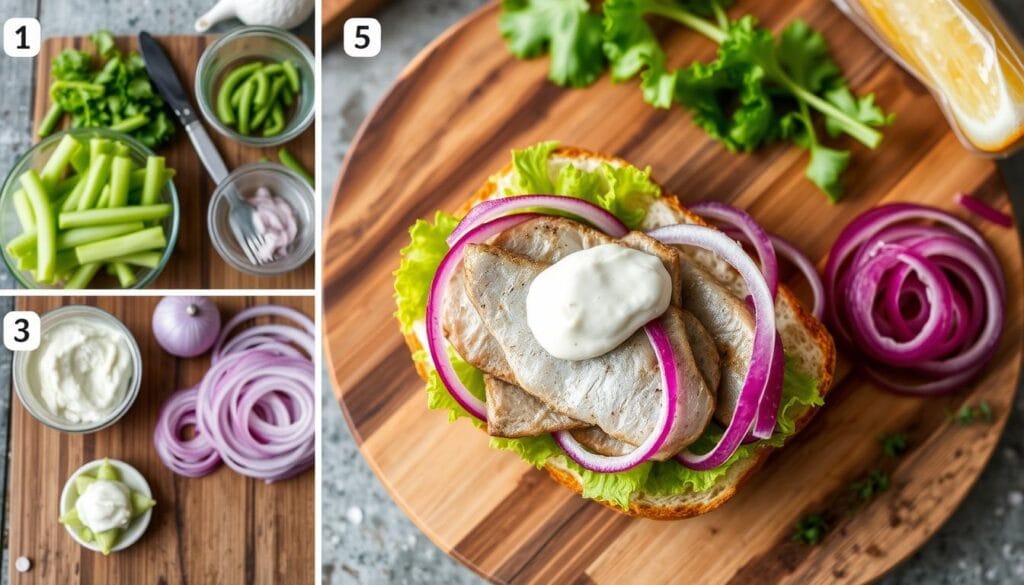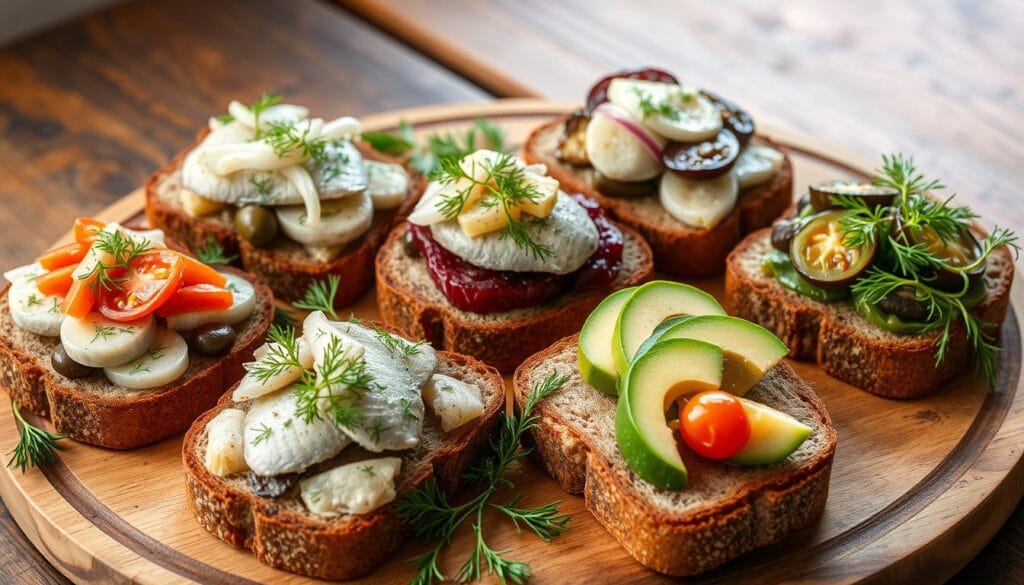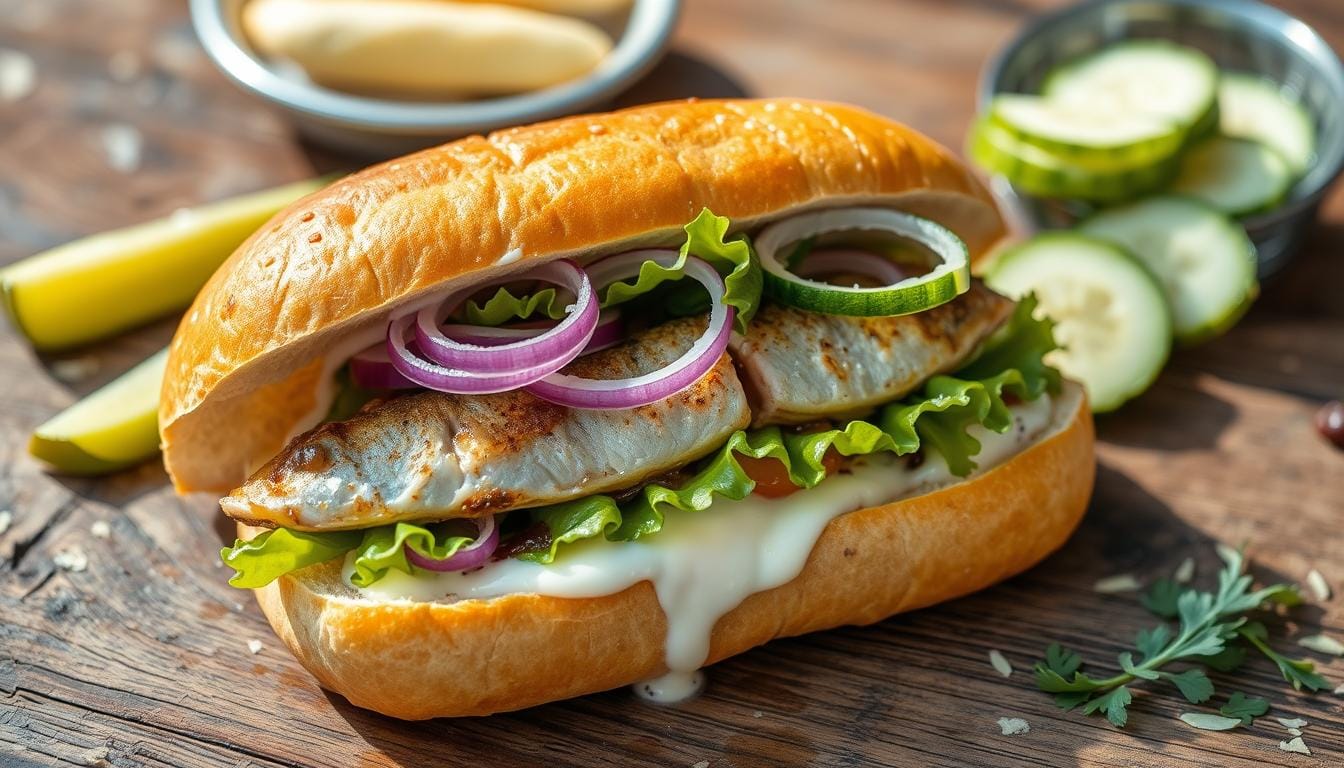Imagine biting into a culinary treasure that captures the essence of Northern German coastal cuisine. The Matjesbrötchen recipe brings an extraordinary seafood experience straight to your kitchen. It transforms a simple sandwich into a protein-packed delicacy that tells a story of tradition and flavor.
Matjesbrötchen isn’t just a sandwich—it’s a cultural journey. It’s made from young herrings caught before spawning. This dish represents about 20% of the total herring catch in Northern Europe. The term “matjes” comes from the Dutch word “maatjesharing,” meaning “maiden herring,” showing the young age of the fish used in this remarkable recipe.
What makes this Matjesbrötchen recipe special is its unique preparation. The herring is delicately brined with just 1.5% to 3% salt, creating a milder flavor compared to traditional salted varieties. A typical serving packs an impressive 18-20 grams of protein, making it delicious and nutritionally robust.
As you embark on this culinary adventure, you’ll discover why Matjesbrötchen has become a beloved street food in Germany. With about 25% of the fish sandwich market in urban areas, this dish represents more than a meal—it’s a cultural experience waiting to be savored.
Ready to transform your home cooking and impress your family with an authentic German delicacy? Let’s dive into the world of Matjesbrötchen ingredients and uncover the secrets of this remarkable sandwich.
Table of Contents
Understanding the German Culinary Tradition
Explore the world of Matjesbrötchen, a German culinary gem, and symbol of northern coastal cuisine. This dish is more than food; it’s a celebration of culture and tradition.
Origins in Northern German Coastal Cuisine
The history of matjesbrötchen dates back to the 18th century. It started in Northern Germany’s coastal areas. Fishermen created this method to preserve herring, turning a survival need into a culinary art.
This tradition began in maritime towns like Hamburg and Emden. It was a way to keep fish fresh during long winters. Over time, it evolved from a survival food to a beloved tradition.
- Originated in coastal towns like Hamburg and Emden
- Developed as a method to preserve fish during long winters
- Evolved from a survival food to a cherished culinary tradition
Cultural Significance and Heritage
Matjesbrötchen is more than food; it’s a symbol of community. It brings people together during special times like New Year’s Eve and Christmas markets, and its flavors and preparation connect generations.
| Cultural Aspect | Significance |
|---|---|
| Community Gatherings | Central to family reunions and festivals |
| Regional Pride | Represents Northern German culinary identity |
Modern-Day Popularity
The nutritional benefits of matjesbrötchen have made it popular today. It’s full of omega-3 fatty acids and protein. This appeals to health-conscious eaters while keeping its traditional roots.
Today, chefs are adding new twists to the classic recipe, using ingredients like avocado and sriracha mayo. Yet, the dish’s heart stays true to its coastal origins.
- Contains approximately 210 calories per 100 grams
- Rich in protein (20 grams per 100 grams)
- Provides essential vitamins D and B12
What Makes Matjes Herring Special
Matjes herring is a treasure in German food, known for its special preparation. It’s caught young and cured in a way that changes its taste and feel.
Choosing the right herring is key to making matjesbrötchen. Young fish, picked from May to June, are processed to make a mild and soft treat. This ensures your sandwich gets the best ingredients.
Unique Characteristics of Matjes Herring
- Harvested at a young age before full sexual maturity
- Mild, delicate flavor profile
- Soft, tender texture
- Rich in essential nutrients
Matjes herring is also very nutritious. A 100-gram serving offers great health benefits:
- Omega-3 Fatty Acids: 2.2g
- Protein: 25g
- Vitamin D: 680 IU
- Vitamin B12: 13.9 µg
- Selenium: 40 µg
When making matjesbrötchen, pick MSC Certified herring for the best quality. The brining and fermentation give it a unique taste, making it a key part of Northern German coastal food.
Knowing these special traits helps you make your matjesbrötchen. Its young age and careful processing make it both healthy and tasty.
Essential Ingredients for Your Matjesbrötchen Recipe
To make a real Matjesbrötchen, you need the right ingredients. These ingredients bring the taste of Northern German coastal food to your table. Start by knowing what makes this sandwich special.
Selecting the Perfect Matjes Herring
The main ingredient is the matjes herring. Find fresh, firm, and shiny herrings. Soaking it in milk for 10-15 minutes helps soften it and makes it taste better.
- Choose 2-3 fresh herring fillets per serving
- Ensure the herring is firm and has a glossy appearance
- Soak in milk to soften and reduce salt intensity
Choosing the Right Brötchen
You also need the right bread roll. Traditional German Brötchen is the best choice. If you can’t find these, look for crusty, fresh bread rolls with a soft inside.
Additional Components and Seasonings
Add extra ingredients to make your Matjesbrötchen even better. Traditional toppings include:
- Thinly sliced yellow or red onions (about ½ cup)
- Fresh dill for a bright, herbal note
- Optional extras like pickles, capers, or lettuce
Today, people also add things like avocado and beetroot. This shows the dish is still loved and changing.
The Art of Bread Selection and Preparation
Choosing the right bread is key to a great matjesbrötchen. The bread you pick can make a big difference, turning a simple sandwich into a feast for the taste buds.
- Soft inside with a crispy outside
- Can soak up herring brine without getting soggy
- Has a neutral taste that goes well with the herring
Here are some traditional bread for matjesbrötchen:
| Bread Type | Texture | Flavor Profile |
|---|---|---|
| Kaiser Roll | Crisp outside, soft inside | Mild, slightly buttery |
| Rye Bread | Dense, hearty | Robust, earthy |
| Multigrain Roll | Grainy, substantial | Nutty, complex |
For a better matjesbrötchen, lightly toast your bread. It makes the bread better for your herring sandwich. Toasting helps the bread keep its shape while soaking up the tasty flavors.
Try sourdough or brioche for a modern twist. They bring new flavors to the classic matjesbrötchen, allowing you to add your own touch while keeping the dish’s roots.
Mastering the Creamy Sauce Components
Making the perfect sauce is key to a great matjesbrötchen recipe. The right sauce can turn a simple herring sandwich into a dish that’s both tasty and true to German cuisine.
Traditional Sauce Variations
German cuisine has many classic sauce options for matjesbrötchen. The top choices are:
- Creamy dill sauce with fresh herbs
- Tangy remoulade with pickles and capers
- Light yogurt-based sauce with lemon juice
Homemade Sauce Techniques
Making your sauce lets you control the flavors and quality. For a real matjesbrötchen recipe, try these homemade methods:
- Begin with sour cream or Greek yogurt
- Add finely chopped fresh dill
- Add a dash of salt and white pepper for seasoning
- Squeeze fresh lemon juice for brightness
Balancing Flavors
The secret to a great matjesbrötchen is balanced flavors. Your sauce should enhance the matjes herring’s rich, briny taste without overpowering it. Try different herbs and adjust the acidity to get the perfect mix.
Pro tip: Let your homemade sauce rest for 30 minutes before serving. This lets the flavors blend, making the sauce even better for your matjesbrötchen.
Step-by-Step Guide to Assembly

Making the perfect matjesbrötchen needs care and focus. Start by picking top-notch ingredients. These will turn simple parts into a tasty German treat.
First, gather these key ingredients:
- 400 grams of premium pickled matjes herring
- 4 fresh Kaiser rolls or sourdough buns
- Creamy sauce ingredients
- Optional garnishes
Here’s how to make authentic matjesbrötchen:
- Bread Selection: Pick rolls with a crunchy outside and soft inside
- Slice rolls carefully, keeping them intact
- Prepare herring by gently patting and trimming
- Make a smooth layer of herring
- Add toppings like chopped eggs or pickles
For the best matjesbrötchen, marinate herring for better taste. Serve it soon after making it to keep it fresh.
| Nutritional Highlights | Per 100g Herring |
|---|---|
| Omega-3 Fatty Acids | 2.2g |
| Protein | 25g |
| Vitamin D | 680 IU |
Your matjesbrötchen is ready when all parts work together. It’s a traditional German dish that honors coastal food traditions.
Serving Suggestions and Presentation
Making the perfect matjesbrötchen is more than just putting ingredients together. Your presentation can turn this German street food into a feast for the eyes and taste buds.
Traditional Accompaniments
- Pair with cold German beer or sparkling water
- Serve alongside a crisp green salad
- Add traditional German potato salad as a side dish
Modern Serving Ideas
Try new ways to serve matjesbrötchen that mix tradition with modern tastes:
- Garnish with fresh dill and lemon wedges
- Add a dollop of homemade dill sauce
- Experiment with alternative bread options like rye or gluten-free rolls
Plating Techniques
The secret to a great matjesbrötchen presentation is in how you put it together. Use white plates to make the sandwich’s colors pop. Place two to three pieces of matjes herring in each roll, with toppings like thinly sliced red onions and pickles spread out.
Matjesbrötchen is best eaten right after you make it. This keeps the texture and taste just right. You aim to make a dish that looks as good as it tastes, capturing the spirit of Northern German coastal food.
Regional Variations and Creative Twists

Exploring matjesbrötchen variations shows the rich culinary diversity in Germany and nearby countries. Each area adds its special touch to this classic herring sandwich. This turns a simple dish into a lively culinary adventure.
Northern German coastal areas keep their matjesbrötchen simple. They use matjes herring, fresh onions, and butter on crusty rolls. But, Southern variations add more complex flavors:
- Creamy dill sauce
- Pickled vegetable accompaniments
- Herbs like chives or parsley
Scandinavian versions of matjesbrötchen are exciting. Danish and Swedish ones often include:
- Robust rye bread
- Boiled egg slices
- Fresh apple garnishes
The Dutch add their own twist with sweet pickles and raw herring, which shows how a single idea can be interpreted in different ways across cultures. Spicy lovers might enjoy versions with chili flakes or zesty horseradish, while health-focused people can choose whole-grain rolls.
When making your matjesbrötchen variations, remember quality ingredients and creative mixes are crucial. They help make this classic sandwich even better.
Conclusion
Your journey through the Matjesbrötchen recipe is more than a sandwich. It’s a dive into Northern German coastal cuisine. By mastering this dish, you’ve connected with Hamburg and Bremen’s seafood traditions.
The Matjesbrötchen recipe is very versatile. You can keep it simple with onions and pickles or try new things like spicy aioli. It’s a blank canvas for your creativity.
This sandwich is nutritious in addition to being delicious. It’s full of omega-3s, protein, and vitamin D. Learning to make it opens doors to more international dishes and expands your cooking skills.
Share your Matjesbrötchen with loved ones. Each bite shares a story of tradition, freshness, and Northern Germany’s culinary world. It’s a taste of Germany, right in your kitchen.
FAQ
What exactly is a Matjesbrötchen?
How is Matjes herring different from regular herring?
Can I make Matjesbrötchen if I can’t find authentic German Brötchen?
Is Matjesbrötchen a healthy food option?
What are the traditional toppings for Matjesbrötchen?
How should I store Matjes herring?
Are there vegetarian alternatives to Matjesbrötchen?
What drinks pair well with Matjesbrötchen?
Can I prepare Matjesbrötchen in advance?
How do different regions in Germany prepare Matjesbrötchen?

Authentic Matjesbrötchen Recipe You Need to Try
Equipment
- 1 Cutting board
- 1 Knife
- 1 Small bowl
- 1 Spoon
- 1 Serving plates
Ingredients
- 4 fresh bread rolls (Kaiser rolls or crusty buns)
- 4 matjes herring fillets
- 1 red onion, thinly sliced
- 1 small apple, thinly sliced
- 1 small cucumber, thinly sliced
- 4 leaves of lettuce (optional)
- 2 tablespoons mayonnaise or remoulade sauce
- 1 teaspoon fresh dill, chopped (optional)
- Lemon wedges, for garnish
Instructions
- Prepare the Bread Rolls: Slice the rolls in half horizontally. If desired, lightly toast them for extra crispiness.
- Assemble the Base: Spread a thin layer of mayonnaise or remoulade sauce on the bottom half of each roll.
- Layer the Ingredients: Place a lettuce leaf on the bottom half of the roll.Lay one matjes herring fillet over the lettuce.Add a few slices of red onion, apple, and cucumber on top of the herring.
- Top it Off: Sprinkle chopped dill for an extra touch of freshness, if desired.
- Finish the Sandwich: Close the roll with the top half and press gently to hold everything together.
- Serve and Enjoy: Serve immediately with lemon wedges on the side for an added zest.

